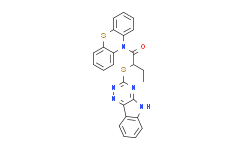| 中文名称: | Inauhzin | ||||
|---|---|---|---|---|---|
| 英文名称: | Inauhzin | ||||
| 别名: | Inauhzin 2-((5H-[1,2,4]triazino[5,6-b]indol-3-yl)thio)-1-(10H-phenothiazin-10-yl)butan-1-one | ||||
| CAS No: | 309271-94-1 | 分子式: | C25H19N5Os2 | 分子量: | 469.58 |
| CAS No: | 309271-94-1 | ||||
| 分子式: | C25H19N5Os2 | ||||
| 分子量: | 469.58 | ||||
基本信息
|
产品编号:I10168 |
|||||
|
产品名称:Inauhzin |
|||||
|
CAS: |
309271-94-1 |
储存条件 |
粉末 |
-20℃ |
四年 |
|
|
|
||||
|
分子式: |
溶于液体 |
-80℃ |
两年 |
||
|
分子量 |
469.58 |
-20℃ |
一个月 |
||
|
化学名: |
2-((5H-[1,2,4]triazino[5,6-b]indol-3-yl)thio)-1-(10H-phenothiazin-10-yl)butan-1-one |
||||
|
Solubility (25°C) |
体外 |
DMSO |
94mg/mL (200.17mM) |
||
|
Ethanol |
Insoluble |
||||
|
Water |
Insoluble |
||||
|
体内 |
现配现用 |
|
|||
|
<1mg/ml表示微溶或不溶。 |
|||||
|
普西唐提供的所有化合物浓度为内部测试所得,实际溶液度可能与公布值有所偏差,属于正常的批间细微差异现象。 |
|||||
|
请根据产品在不同溶剂中的溶解度选择合适的溶剂配制储备液;⼀旦配成溶液,请分装保存,避免反复冻融造成的产品失效。 |
|||||
制备储备液
|
浓度
溶液体积 质量 |
1mg |
5mg |
10mg |
|
1mM |
2.1296mL |
10.6478mL |
21.2956mL |
|
5mM |
0.4259mL |
2.1296mL |
4.2591mL |
|
10mM |
0.2130mL |
1.0648mL |
2.1296mL |
|
50mM |
0.0426mL |
0.2130mL |
0.4259mL |
生物活性
|
产品描述 |
一种SirT1/IMPDH2的双重抑制剂,同时为p53的激活剂。 |
|
|
靶点/IC50 |
SIRT1 |
p53 |
|
体外研究 |
Inauhzin (10µM) induces p53 levels as effectively as actinomycin D (10nM), and mediates p53-dependent cytotoxicity through its specific functional groups in human lung carcinoma H460 cells. Inauhzin (2µM) induces p53 level and activity as well as p53-dependent apoptosis. Inauhzin also stabilizes p53 and inhibits its ubiquitylation. Inauhzin induces acetylation of p53 in H460 cells, but not tubulin, which is affected by knockdown of SIRT1. Inauhzin (0-2 µM) significantly enhances the expression level and activity of p53 in HCT116p53+/+ cells and enhances the expression level and activity of p53 in H460 cells in a dose-dependent manner. Inauhzin and Nutlin-3 demonstrate synergistic cytotoxicity in the Nutlin-3 low-sensitive cells. Inauhzin and Nutlin-3 synergistically induce p53-dependent apoptosis. Inauhzin targets both SirT1 and IMP dehydrogenase 2 (IMPDH2), and acts as a potent p53 activator. |
|
|
体内研究 |
Inauhzin (30mg/kg, i.p.) effectively induces apoptosis and suppresses tumour growth of H460 xenograft harbouring p53. Inauhzin (30mg/kg, i.p.) reduces the HCT116 tumor volume by appr 70%. Inauhzin (15mg/kg) in combination with 150mg/kg of Nutlin-3 demonstrates a significant synergy on p53 induction, apoptosis and tumor suppression of HCT116p53+/+ xenografts. |
|
推荐实验方法(仅供参考)
|
细胞实验: |
|
|
Cell Assay |
The cell counting kit is used to assess cell growth. Cell suspensions are seeded at 5000 cells per well in 96-well culture plates and incubated overnight at 37°C. Compounds are added into the plates and incubated at 37°C for 72 h. Cell growth inhibition is determined by adding WST-8 at a final concentration of 10% to each well, and the absorbance of the samples is measured at 450nm using a Microplate Reader. |
|
动物实验: |
|
|
Animal Administration |
Five-weeks-old female SCID mice are housed in a BSL2 environment. Mice are subcutaneously inoculated with 5×106 H460 or 3×106 HCT116 cells. Tumour growth is monitored every other day with electronic digital calipers in two dimensions.Tumour volume is calculated with the formula: tumour volume (mm3) = (length × width2)/2. When the mean tumour volume reaches approximately 100 mm3 after 7-9 days, animals are dosed by i.p. injection with vehicle (5% DMSO) or Inauhzin. Inhibition of tumour growth is calculated on the last day of treatment. To detect p53 activation in vivo, tumours are harvested and disrupted in RIPA buffer containing a protease inhibitor mixture. Tumour lysates are analysed by IB. Cell proliferation in tumours is assessed by BrdU labeling followed by Immunostaining. 200mg/kg body weight of BrdU is administrated to mice via i.p. injection 2 h before mice are sacrificed. Apoptosis is examined by TUNEL staining, using the Fluorescein In situ cell death detection kit |
本计算器可帮助您计算出特定溶液中溶质的质量、溶液浓度和体积之间的关系,公式为:
质量 (g) = 浓度 (mol/L) x 体积 (L) x 分子量 (g/mol)
摩尔浓度计算公式
用本工具协助配置特定浓度的溶液,使用的计算公式为:
开始浓度 x 开始体积 = 最终浓度 x 最终体积
稀释公式
稀释公式一般简略地表示为:C1V1 = C2V2 ( 输入 输出 )








